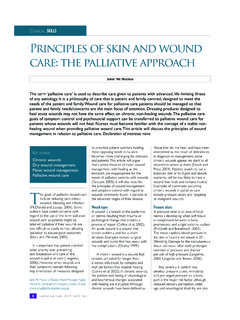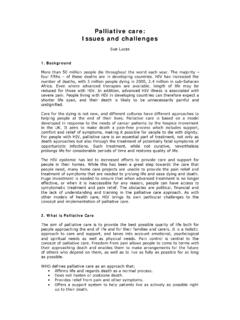Transcription of Palliative and end of life care guidelines
1 Palliative and end of life careguidelinesfor cancer and non-cancer patientsThird edition: 2012 North of EnglandCancer NetworkNORTH OF ENGLAND CANCER NETWORK Palliative care GUIDELINESNORTH OF ENGLAND CANCER NETWORK Palliative AND END OF life care GUIDELINESFOREWORDT hese guidelines have been written for clinical staff who provide Palliative and end of life care topatients within their usual role this work is often referred to as generalist Palliative care . Theguidelines do not attempt to cover specialist Palliative care for which much more comprehensivetexts and resources hope that this concise guideline booklet will provide clear and accessible information for use inthe patient s home, in the surgery and on the 3rd edition has been redrafted and updated by wide consultation across the Network,including partners in regional groups beyond Palliative care . The result is content that, as far aspossible, represents a consensus informed by available evidence. It is in the nature of the specialtythat research in some areas is limited and much established practice is based upon evolving expertopinion and expanding clinical , the guideline information is relevant to all Palliative care patients regardless ofdiagnosis.
2 Where specific guidance applies, this is highlighted in the use of drugs beyond licence ( off-label ) in Palliative care and pain management practice iscurrently both necessary and common and should be seen as a legitimate aspect of clinical practice.(APM/BPS 2008) guidelines are a place to begin. They cannot replace specialist advice from experienced to the practice of Palliative care is an emphasis on individualised care for the symptoms fail to respond to usual measures, or if you are concerned that the recommendationsgiven here may not be appropriate to the clinical situation, please contact your local specialistpalliative care team. Contact numbers are listed on the final pages of this are due to all who have contributed to the development of these contributors hope you find these guidelines both clear and helpful, to the benefit of thepatients in your care and to your own practice. Observations or comments which may informfuture review of this booklet are welcome and should be directed to the NECN Alison FeatherstoneNECN Palliative care Clinical LeadDr Alex Nicholson FRCPC onsultant in Palliative Medicine1 NORTH OF ENGLAND CANCER NETWORK Palliative care GUIDELINESNORTH EAST CANCER NETWORK Palliative AND END OF life care GUIDELINESIMPORTANT NOTE:The most significant change in this revised edition is that MORPHINE is the recommended firstline subcutaneous opioid, replacing applies for doses of subcutaneous morphine up to 360mg/24hrs.
3 If the calculated subcutaneous morphine dose requirement exceeds 360mg/24hrs it will benecessary to switch to an alternative opioid because of resulting volume constraints in therescue dose. You should seek specialist advice in this further information see pages 5 to care .. 2 Pain .. 3 Using Opioids for Pain in Palliative care .. 5 Constipation .. 10 Nausea and Vomiting .. 12 Corticosteroids in Palliative care .. 14 Control of Glucose in Patients on Corticosteroids .. 15 Depression and Anxiety .. 16 Emergencies Metastatic Spinal Cord Compression (MSCC) .. 18 Emergencies Malignant Hypercalcaemia .. 19 Emergencies Major Haemorrhage ..20 Emergencies Malignant Superior Vena Cava Obstruction .. 21 Diabetes Management at the End of life .. 22 Pain at the End of life .. 23 Pain at the End of life in Renal Failure .. 24 Pain at the End of life Supplementary Information .. 25 Nausea and/or Vomiting at the End of life ..26 Restlessness and/or Agitation at the End of life .
4 27 Respiratory Tract Secretions at the End of life ..28 Breathlessness at the End of life .. 29 Breathlessness at the End of life in Renal Failure .. 30 Specialist Palliative care Services Contact Details ..31 Additional References .. 32 For the most part, dose guidance included in these guidelines is in line with the British National Formulary(BNF). Where the guidance differs and follows the Palliative care Formulary 4th Edition (PCF4), this ishighlighted in the RESOURCES(further references are listed on the final page)Dickman A. (2011) The syringe driver. Oxford University Press, OxfordRegnard C & Dean M. (2010) A guide to symptom relief in Palliative care . 6th edition. Radcliffe Press, R, Wilcock A (2011) Palliative care Formulary. 4th Edition. Ltd., M, Lucas C, Hoy A & Back I. (2005) Oxford Handbook of Palliative care . Oxford University Press, 62 (September 2011) BMJ Group and Pharmaceutical Press, CAREThe WHO defines Palliative care as: the active, holistic care of patients with advanced, progressive illness.
5 Management of pain andother symptoms and provision of psychological, social and spiritual support is paramount. Thegoal of Palliative care is achievement of the best quality of life for patients and their families. The principles of Palliative care are relevant to patients with both malignant and non-malignantdisease and may be relevant to patients early in their disease trajectory. Therefore the principles ofpalliative care should not be applied solely to cancer patients at the end of life . The commonest symptoms include:PainAnxietyFatigueBreathlessness NauseaVomiting Diarrhoea DepressionConfusion AnorexiaInsomniaConstipationKey principles of symptom managementSeveral principles are fundamental to the Palliative care approach: Conduct a detailed assessment in partnership with patient and carers Diagnose cause of symptom(s) using knowledge of pathophysiology and disease processes Choose appropriate treatment for the individual balancing benefit against side effect burdenand considering factors such as route of administration Avoid making too many changes at once or review will be complex Constantly reassess: review, review, review Anticipate future problems and plan ahead as much as guideline booklet does not address every symptom and it is not the intention of the booklet toreplace the excellent handbooks of Palliative care and symptom control which exist.
6 Its purpose isto provide: convenient and accessible information on management of common symptoms key points in management of the main Palliative care emergencies guidance on management of symptoms in the last days of life guidance on managing diabetes in Palliative care (follow local service guidelines where these arein place)Further guidelines and useful links can be accessed via the North of England Cancer Networkwebsite - OF ENGLAND CANCER NETWORK Palliative AND END OF life care GUIDELINES3 PAINThe concept of TOTAL PAIN is commonly used in Palliative care to prompt health professionals toconsider all possible influences on the pain experience:When to consider support from the Specialist Palliative care Team (SPCT)SPCTs are experienced in the management of complex pain and will offer advice on the use ofstandard, adjuvant and non-drug measures to manage pain or will be happy to see the patient forassessment, treatment and review. The following situations warrant referral: Complex or multiple pains where assessment is difficult Pains that appear resistant to usual measures Difficulty with management caused by adverse effects of medication Pain associated with more than usual distress, particularly where non-physical factors in doubt, please ask your local SPCT for OF ENGLAND CANCER NETWORK Palliative AND END OF life care GUIDELINESA ssessment it is essential to try to determine the CAUSE of the pain to guide managementPHYSICALTOTAL PAINSOCIALSPIRITUALP rescribing guidancePain is an unpleasant sensory and emotional experience associated with actual or potential tissue damage.
7 It is a highly subjective definition: pain is what the patient says hurts PSYCHOLOGICAL Use the oral route wherever possible. Use a non-oral route if necessary, dysphagia, vomiting, bowel obstruction, terminal phase. Prescribe regularly at a dosing interval appropriate to the formulation. Prescribe as required analgesia for pain that may occur despite regular initial assessment is very important andshould include clear documentation of findings. Thisallows the assessing clinician, and others, to compareprogress in management against the early pains change with time and frequentreassessment is necessary, especially during and afterinterventions. Multiple sites and/or types of pain arecommon. EACH pain should be assessed,documented, managed and may be used to record site & radiation ofpains, and associated clinical findings. Pain scores orscales, though subjective, allow the patient to ratethe severity of the pain should be assessed for Site, severity, radiation and characteristics of itstiming/frequency/variation Quality using descriptive terms ( burning,tingling, throbbing, etc) Exacerbating and relieving factors including theeffects of drug & non-drug interventions Associated symptoms and featuresPatient s understanding, fears & concerns, previousexperience of pain and expectations of treatment,and other aspects relevant to social, psychologicaland spiritual, should be examination should be performed to assist indetermining the likely type and cause.
8 Relevantinvestigation, appropriate to the patient s condition,should be considered. This might includebiochemistry (which may influence drug choice) andX- The WHO analgesic ladderprovides a framework for Palliative pain management Move up to the next step if pain control is not Use NSAIDs with great care in this patient groupAdjuvant analgesic drugs(co-analgesics) may be used alongside any step of the ladder. Anadjuvant analgesic is a drug whose primary indication is for something other than pain, but whichhas analgesic effects in some painful conditions. Dose guidance for use of corticosteroids isincluded on Additional approachesto pain relief will be dictated by clinical circumstances: Interventional methods- spinal analgesia, nerve block, radiotherapy, orthopaedic or spinalsurgical stabilisation. Non-drug measures- TENS, acupuncture, massage, complementary therapies, CBT Rehabilitative support- physiotherapy, occupational therapy Adverse effectsPrescribers must know the adverse effects and contraindications of all medications that theyprescribe and should consult the BNF if they are unsure.
9 Common adverse effects of opioids areexplained on page : Combinations of certain drugs ( NSAIDs, corticosteroids, SSRIs and anticoagulants) increasesubstantially the risk of GI bleeding. Co-prescription of a PPI and close monitoring is essential. Review, review, review Success in pain management depends upon regular review of pain and its causes, and theeffectiveness of the treatment and its acceptability to the OF ENGLAND CANCER NETWORK Palliative AND END OF life care GUIDELINESSTEP 1 Non-opioid (Paracetamol and/or NSAID) +/- adjuvantSTEP 2 Opioid for mild to moderate pain +/- non-opioid (Paracetamol and/or NSAID) +/- adjuvantOpioid for mild/moderate pain = codeine, dihydrocodeine, tramadolSTEP 3 Opioid for moderate to severe pain +/- non-opioid (Paracetamol and/or NSAID) +/- adjuvantOpioid for severe pain = morphine, diamorphine, oxycodone, fentanyl, hydromorphone(for rescue analgesic, use 1/6th daily dose of regular opioid)Common adjuvant analgesic drug groupsIndicationsCorticosteroidsRaised intracranial pressure, nerve compression, liver capsular pain, soft tissue infiltrationAntidepressants, AnticonvulsantsNeuropathic pain, tenesmoid painMuscle relaxants ( baclofen, benzodiazepines)
10 Muscle cramp/spasm, myofascial painBisphosphonatesBone painAntispasmodic ( hyoscine butylbromide)Bowel colic, bladder spasmUSING OPIOIDS FOR PAIN IN Palliative CAREU sing opioid drugs safelyMorphine and other opioids are valuable drugs for the relief of severe pain in patients withadvanced malignant and non-malignant disease. These drugs are safe, effective and appropriateprovided that: cautious starting doses and titration are observed the properties and relative potencies of different strong opioids are understood opioid-related adverse effects are monitored and managed prescribers are aware that some types of pain respond poorly to opioids and require other typesof analgesics (adjuvant analgesics)Common concerns over the use of morphine and other opioidsOpioids and addiction - Clinical experience indicates that when opioids are titrated againstmoderate/severe opioid responsive pain, addiction is exceptionally rare. Patients should bereassured that if the pain is relieved by some other intervention, the opioid drug can be reducedand discontinued without adverse effect.






